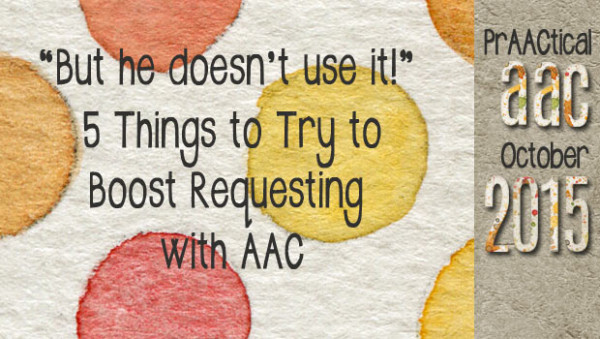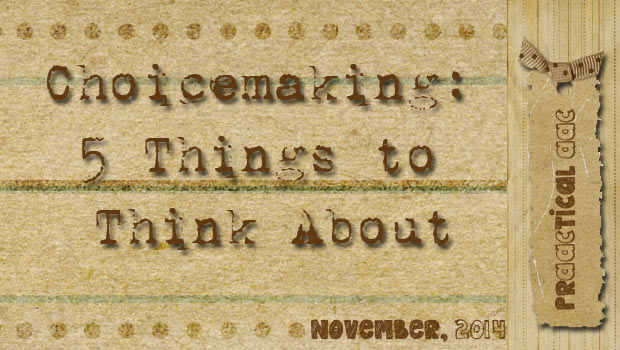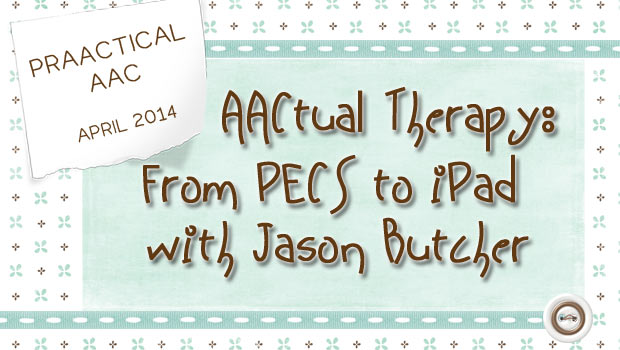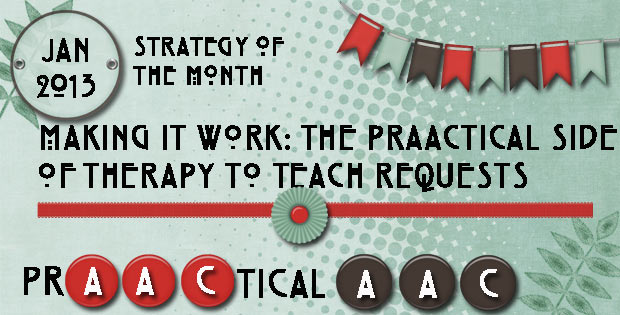“But he doesn’t use it!” 5 Things to Try to Boost Requesting with AAC

You did the assessment and got funding for the AAC device/app/aid. You regularly implement aided language input and your therapy is progressing nicely. You’ve spent time with teachers, paraprofessionals, family members, and others to educate them about AAC. You’ve worked with them to develop some initial goals around requesting wants/needs (even though that wasn’t your favorite place to start). You’ve identified some of his favorite things and even programmed language that allows him to request ‘something else’ if he doesn’t care for any of the choices. The foundation is set and things should be coming along. So what’s the problem?
Well, it seems that the AAC learner hasn’t quite gotten the memo. Sigh. Rather than use the amazing AAC tool to ask for what he wants, Jonah continues to reach, grab, whine, and cry to get his needs met in most situations. Yes, progress is happening, but s-l-o-w-l-y. You have a sinking feeling that if things don’t start to move more quickly, the team will lose steam and implementation will dwindle.
How can we speed up the process? Here are a few things to try.
1. Do a fidelity check to be sure that aided language input is pervasive throughout the day. The more WE use AAC, the more the learners will follow suit.
2. Consider implementing some massed trials to help the learner see the purpose of the AAC and experience success. That might look something like this:
- Set up some interactions with favorite things.
- Arrange the environment to use controlled access to tempt communication.
- Use errorless learning to assist him in using the AAC tool to get the desired toy/item/activity. (The goal here is for him to expend minimal time/effort in using the AAC to get what he wants. Independence is not the priority just yet, so we want to do whatever we can to make it fast, easy, and successful.)
- Quickly give him what he asked for and let him enjoy it for a minute or so.
- Then you take a turn with the favored toy/item for a (very) few seconds.
- Repeat the communication temptation, support his for requesting with AAC, and provide the natural contingency (receiving the item that was requested).
Do your best to keep it fun, light, and respectful. Communication should never have the look and feel of a chore. Brief sessions (5 minutes) spaced throughout the day can make a big difference. Doing this often, in an upbeat, fast-paced way with different sets of materials will help him connect the dots to see how the AAC can help him get his own agenda met. Remember, lots of short mini-sessions are better than a few long ones.
3. Step back and reflect on the learner’s errors to see if any patterns emerge. Maybe there are access problems that can be addressed, or maybe the materials themselves lost their motivational value. (We can’t teach someone to ask for something they don’t want.) When we are running these sessions or teaching these lessons, it can be very hard to pick out the trouble spots while we’re handling everything else. Give yourself some time to step back, observe, and see if you get any insight as to why the learning isn’t progressing as expected.
4. Check to be sure the new communicative behavior (AAC) isn’t any more difficult than the existing way of making requests (e.g., whining, yelling, grabbing). Would any of us use a new tool that was more challenging than the one we’re already using?? Only if there was a clear advantage to doing so. To us, the advantages are obvious, but for our AAC learners, they are both means to the same end. This is a good time to take a closer look at how the target language is stored in the AAC device/app and how the learner is accessing it. Are things we can do to the tool itself to make things easier? You might consider tinkering with the access settings for hold/dwell time, creating thicker borders around cells, or increasing the amount of space between items, among other things. The bottom line: If the AAC is harder to use and no more effective than the current means of requesting, the learner has zero incentive to utilize the new tool.
5. Try video modeling. (Unlike most SLPs, kids LOVE to see themselves in videos.) You can also write a story about it. It never hurts to build understanding of what the expected behavior is. Not every learner will process the language or respond to this, but some will. We’ve done them in a few ways, such as ‘How I Talk’ (showing different ways that the learner communicates) and ‘Me and My Talker’ (showing different things the learner can do with his/her AAC). A simple narrative isn’t going to fully solve the problem in most cases, but even if it helps a little bit, it may be worth the effort.
During times of slow progress, it takes effort to keep the team’s morale up so don’t be afraid to provide a little more encouragement and support. When kids aren’t progressing at the rate we expected, we often feel frustrated or fearful. A bit of sincere cheerleading and authentic recognition of their efforts is in order. What?! That’s not in our scope of practice? Maybe not in so many words, but think of it as differentiation. This is what leadership, advocacy, and teamwork looks like in some situations.
As we all know, requesting isn’t everything. But it IS something. For some beginning communicators, it is the perfect place to start our intervention both because it makes sense to the team and because it gives the learner a way to impact his/her environment.
Do you have strategies to boost skill development when students are learning to use AAC to make requests? We’d love to hear about them.
Filed under: PrAACtical Thinking
Tagged With: requesting
This post was written by Carole Zangari




